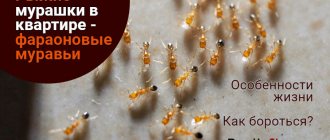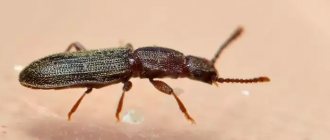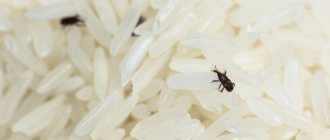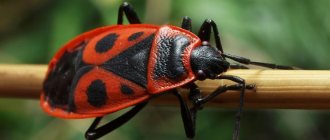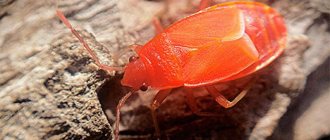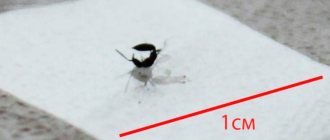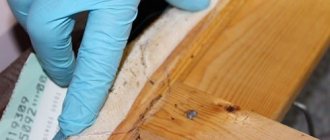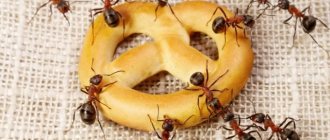Sooner or later, almost every kitchen is faced with an invasion of parasites. It is noteworthy that the appearance of worms does not at all depend on the housewife’s neatness: they can appear even in a perfectly clean kitchen.
Any kitchen can be attacked by a wide variety of parasites.
Let's figure out how these parasites threaten your kitchen, where they come from and, most importantly, how to get rid of bugs in the kitchen.
Why do bugs appear in the kitchen?
First of all, you need to understand that if you have food in your kitchen, then bugs can appear in any case, no matter how hard you try to maintain order.
Cereals receive bugs while still in the warehouse.
There may be several sources of infection:
- The most common way bugs appear in the kitchen is from the grocery store. Do not be surprised. Even a hermetically sealed bag of cereal can contain parasite larvae and adults. They can get into cereals and groceries both directly during sorting and already in the store if storage conditions are violated.
- From neighbors through ventilation. If your neighbors turn a blind eye to the problem, sooner or later strike squads of bugs will make their way to you through the ventilation. Since they reproduce very quickly, their presence will soon become noticeable.
- Some parasites can be found in textiles or wooden products. Therefore, we recommend that you wash towels or oven mitts well, and put wooden utensils in the freezer for a couple of hours.
Note! Even one spotted bug is a reason to be wary and take treatment and prevention measures. Therefore, carefully monitor the condition of your kitchen and do not neglect processing cereals after purchasing them.
In addition, many bugs love animal food, so it is better to put it in the pantry or refrigerator.
Meeting the enemy in person
And now we invite you to get to know the inhabitants of your kitchen better. Here we have collected photos of the 4 most common types of bugs and links to articles from Wikipedia about their characteristics and favorite food.
Below is a photo of the Suriname mucoed (Latin name of the mucoed: Oryzaephilus surinamensis). It is difficult to confuse the Surinamese mucous eater with anyone else due to its saw-toothed body.
Suriname mucoed
Next is a photo of the Flour Beetle or Flour Beetle (Latin name: Tenebrio molitor). By the way, mealworms are the larvae of the mealworm.
Flour beetle
The next photo shows the Bread Grinder, Carpet Beetle or Pharmacy Beetle in the company of their own kind (Latin name for the borer: Stegobium paniceum).
Bread grinder
And finally, a photo of rice weevils or elephants.
Weevils
Types of bugs
It is important to understand that depending on the type of new kitchen inhabitants you have, methods of dealing with them may vary significantly. And sometimes they are not needed at all: for example, small (less than one millimeter) white bugs that can occasionally be seen in the kitchen are ordinary wood bugs. They feed on dust from your furniture, are non-toxic and do not harm human health.
White bugs: not a very pleasant, but harmless neighborhood.
True, there is another side to this - they can serve as food for other bugs with more unpleasant behavior. Therefore, we recommend that you read the information below and try to determine who you are up against and what products you may have to throw away.
One of the most common types of bugs in the kitchen is the red flour beetle. This is a tiny parasite, up to two millimeters in length, with small, hard wings of a bright red color. By themselves, they are quite harmless: they do not eat food and do not live long. However, they multiply quickly. Their small white larvae are almost invisible in foods: flour, rice, oatmeal. Small worms actively feed on cereals, leaving waste in them and spoiling the food.
Red flour eaters feed not only on flour, but also on everything they can get their hands on.
Determine: Musty smell and holes drilled in the grains.
The mealworm is much more dangerous for humans. A brown bug up to three millimeters in size has a mustache and powerful mandibles. You can find it in stocks of flour or potato starch, but there are also not too whimsical individuals for which any crumbly product will suit.
Not only destroys food, but also harms health.
It is noteworthy that they do not strive to completely eat even their favorite flour - as soon as it begins to smell unpleasant, the entire colony migrates to the next container.
Their danger lies in the fact that the waste products of the flour beetle are dangerous to humans and can cause serious poisoning.
Determine: Products gather in lumps and acquire a damp smell.
The peculiarity of the bread grinder is its incredible gluttony. The four-millimeter bug is ready to eat any food that can be found in your kitchen cabinets: flour and pasta, cereals, beans, coffee, tea, nuts, dried fruits and even tobacco.
A small bug can drain all your supplies.
There is no particular harm from it, but a few bugs can ruin a significant amount of stock.
Determine: Usually they don’t hide much, so they are immediately visible.
It should be noted that some people prefer to classify food moths as bugs in the kitchen. This is fundamentally incorrect: moths are a completely different species and need to be dealt with using other methods. We wrote more about how to get rid of food moths in this article.
Where do pests most often occur?
If the kitchen is already infected and there are these insects in flour or cereal, you need to detect foci of infection. You will need to review each of the products.
Bulk products
The following subtleties need to be taken into account:
- It is important that you will need to examine any product, without exception, that is stored in the kitchen. Each type of such bugs has certain gastronomic tastes. But if his favorite food is not available in sufficient quantities, the bug can emigrate from other grains to cereals, as well as sugar, sweets, and nuts. For this reason, you should not skip a single product, so as not to waste a lot of time.
- These parasites become strongly attached to their places of residence, so they do not go far from them. If you see them on the shelf, you must first inspect the products stored nearby.
- Even if the package is hermetically sealed, it will need to be inspected. These insects easily chew through materials such as cardboard, cellophane and foil. For this reason, without opening the cereal, you should not think that it does not contain parasites.
- The best option is to pour the cereal into a plate and watch carefully. These bugs also live hidden - for example, the grinder can gnaw holes in grains and live in them, crawling to the surface only to change the grain. Therefore, a superficial inspection is ineffective.
Are bugs in the kitchen dangerous?
It is difficult to unequivocally assess the harm from the presence of bugs in the kitchen for human health: if you do not eat them directly, they do not seem to be able to do much harm.
Eating such foods is not only unpleasant, but also dangerous.
However, the main danger of parasites is that they leave excrement, shells of larvae, cobwebs and particles of their scales. Such a food supplement will not bring any benefit, and in some cases it can provoke serious anaphylactic shock. Therefore, we still do not recommend there are products that are infested with bugs.
On the other hand, the taste also leaves much to be desired: bugs give all products an unpleasant musty taste, as they eat away their core, leaving only the shell.
Chemical methods and store-bought products
Chemical methods can affect people's well-being, so strict adherence to safety precautions is necessary when using them. As a rule, the instructions for use contain information about the period during which you cannot enter the premises.
On a note!
The most commonly used are insecticides or chlorine and chlorine-containing products.
The store shelves have a huge assortment to suit every taste, color and budget. Here are the most popular options:
- Pyrethrum is considered one of the safest chemicals. It is made in the form of a powder, which is laid out in hidden places and near cereals. The substance is safe for people and animals, but it is better to exercise caution.
- Anti-bug is intended for treating flat surfaces in order to destroy and prevent the appearance of pests (black bugs, food moths). Hazardous to health if it enters human organs.
- Rogneda is another chemical that requires caution in use. It works not only on bugs, but also on many other pests. For example, cockroaches.
- Dichlorvos is a fast-acting aerosol. Effectively eliminates bugs without giving them a chance. Spray only using special protective equipment.
You can use Dust, Whiteness and other compounds. If the owner determines the type of beetle, then you can pick up the remedy in any specialized store.
Prevention of occurrence
As with most problems, it is easier to prevent bugs from appearing in the kitchen than to try to remove them later. We have put together a selection of recommendations for you that will repel parasites from your kitchen and help keep your food safe.
Tip 1. Learn to store food correctly
Do not leave cereals and groceries in their original packaging. This is not very convenient, and it also encourages the appearance of bugs and other parasites. And the safety of cereals leaves much to be desired: they deteriorate much faster in polyethylene.
The bugs will have no chance of getting into the container.
So get yourself some beautiful ceramic, metal or glass containers. In them, food will be preserved much longer, and bugs will not be able to reach it. Unless, of course, you forget to close the lid.
Tip 2. Different temperature conditions
The desire to stock up is a good thing. However, should they all be stored in the kitchen? For most grains, the best place to store them is the refrigerator or even the freezer.
Bugs cannot tolerate low temperatures.
Low temperatures will not give the bugs the slightest chance to reproduce, and will not spoil the taste of the food.
Tip 3. Disinfecting properties
Salt, lemon peel or a couple of chestnuts placed between the products will repel parasites. At the same time, they do not emit unpleasant odors, which means your cereals and groceries will not smell.
Place the selected ingredient in fabric bags and place it on the shelves between containers with bulk products.
Tip 4. Use vinegar
It is not at all necessary to pour it into food: we doubt that this will make rice or oatmeal tastier. But once a week, wiping the shelves with a weak vinegar solution won’t hurt: this way you will remove the eggs and larvae of bugs, preventing them from multiplying.
Vinegar will remove bugs, larvae, and eggs.
Important! Be sure to wipe the shelves dry after treatment if you don’t want to enjoy the aroma of vinegar for a couple more days.
Tip 5: Bugs are afraid of strong odors
Do you want to avoid parasites? Place cardamom or anise seeds, cloves of garlic or nutmeg on the shelves, and place a couple of sprigs of pine needles or wormwood. We recommend, however, not to choose too strong aromas and adhere to the principle of moderation. Otherwise, along with the bugs, the household will disappear from the house.
Scent bomb to fight bugs.
These measures did not help and there are bugs in your kitchen? Then the following section with step-by-step recommendations for getting rid of parasites will be useful to you!
Is it possible to eat contaminated cereals and flour?
Bugs that appear in the kitchen cabinet indicate that the food has been contaminated. Pest control should be started urgently, as they multiply exponentially. Flour, beans, cereals, tea, spices and other groceries are not suitable for human or pet consumption. You need to get rid of them without regret.
Contaminated products
Where does flour beetle come from in an apartment?
The main way for a beetle to enter an apartment is to purchase products that have already been contaminated. Surely you have had a situation where, after buying groceries, you open the package, and there are larvae or bugs swarming around there. Infection occurs in warehouses and storage facilities when storage rules are not followed.
The large beetlefish feels good in the attic with pigeons, lives and reproduces, as it can feed on animal substances, such as the remains of feathers. Once in a multi-storey building with the help of birds, where the beetle cannot find a suitable place for breeding and food, it enters the apartments through the ventilation shafts.
Habitats of the flour beetle
Small Khrushchak prefers to live in warehouses, granaries, pasta factories, but is also found in apartments. Females penetrate into the smallest cracks in boxes, bags or bags of food and even into cracks in walls, breeding under wallpaper. Plastic, paper or fabric are chewed by harmful insects. Due to the fact that the eggs are covered with sticky mucus, they stick firmly to any surface.
For housing, they choose pantries, kitchen drawers (scattered cereal), and places where there is a lot of dust, such as baseboards. This does not mean that pests sit quietly in the products and do not crawl out anywhere; if their numbers are large, they feel like full-fledged masters in the apartment and crawl anywhere, only smooth vertical surfaces are beyond their power. For tormentors, damp, stale foods are preferred, and if there are such places in the house, perhaps you store pasta or cereal on the balcony, in a closet where there is no ventilation, most likely the place where bugs spread is located there.
The large beetle needs high humidity to develop, while the small one lives happily in dry apartments with heating.
How to prevent uninvited “guests” from multiplying
Even if the parasites thrown out along with the cereals never return to the kitchen, some of the insects, having spread throughout the house, will continue to reproduce successfully. To completely eliminate pests, you need to act in three stages.
Inspection of stocks and sending to quarantine
Carefully check all food stored in the house for the presence of voracious insects. Throw away all supplies containing pests. Place cereals in which no traces of pests were found in the freezer for three to four days. After this period, you should carefully sort through the bulk products: if the bugs do not appear, they can be placed in jars for storage.
Washing containers
If cereals attacked by insects were stored in plastic or glass containers, the containers can be disinfected. At home, this can be done like this: soak for half an hour or longer in a strong soap solution, then rinse with running water and dry. It is best to replace the storage jars with new ones, after washing them with soda or laundry soap.
spring-cleaning
You can treat the cabinets to get rid of bugs in the cereal with a strong solution of laundry soap and soda. It wouldn’t hurt to wipe down the shelves, tables, window sills, floors, even the walls in the kitchen. After this, walk over the surfaces with a cloth moistened with a 9% vinegar solution (a tablespoon per liter of water). Pour boiling water over latches in cabinets, cracks in floors and walls.
It is advisable to clean the cabinets with a vacuum cleaner using a narrow attachment: this measure will help get rid of eggs, larvae and pest excrement. Particular attention should be paid to corners, cracks and doors.
